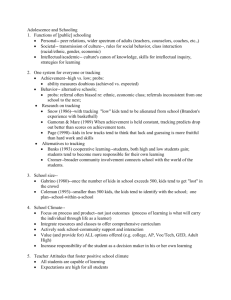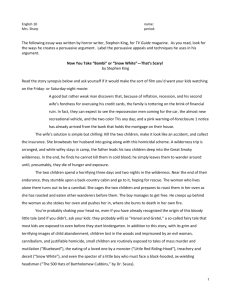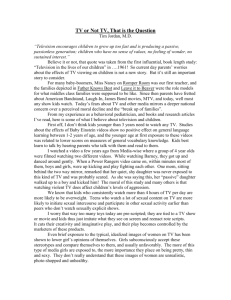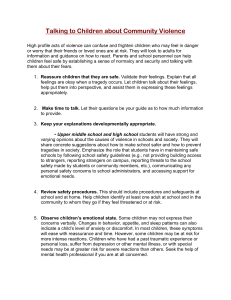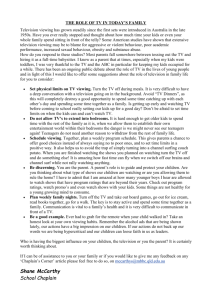CD102 - 1 EFFECTS OF MEDIA -- NOTES Outline I. Introduction to
advertisement
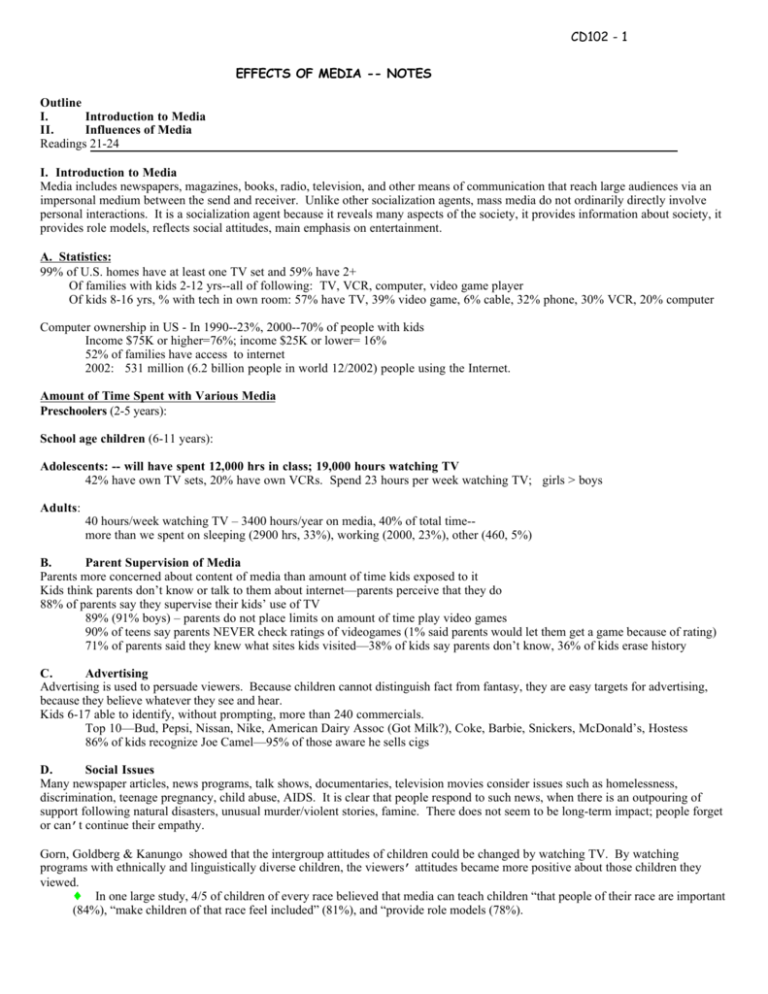
CD102 - 1 EFFECTS OF MEDIA -- NOTES Outline I. Introduction to Media II. Influences of Media Readings 21-24 I. Introduction to Media Media includes newspapers, magazines, books, radio, television, and other means of communication that reach large audiences via an impersonal medium between the send and receiver. Unlike other socialization agents, mass media do not ordinarily directly involve personal interactions. It is a socialization agent because it reveals many aspects of the society, it provides information about society, it provides role models, reflects social attitudes, main emphasis on entertainment. A. Statistics: 99% of U.S. homes have at least one TV set and 59% have 2+ Of families with kids 2-12 yrs--all of following: TV, VCR, computer, video game player Of kids 8-16 yrs, % with tech in own room: 57% have TV, 39% video game, 6% cable, 32% phone, 30% VCR, 20% computer Computer ownership in US - In 1990--23%, 2000--70% of people with kids Income $75K or higher=76%; income $25K or lower= 16% 52% of families have access to internet 2002: 531 million (6.2 billion people in world 12/2002) people using the Internet. Amount of Time Spent with Various Media Preschoolers (2-5 years): School age children (6-11 years): Adolescents: -- will have spent 12,000 hrs in class; 19,000 hours watching TV 42% have own TV sets, 20% have own VCRs. Spend 23 hours per week watching TV; girls > boys Adults: 40 hours/week watching TV – 3400 hours/year on media, 40% of total time-more than we spent on sleeping (2900 hrs, 33%), working (2000, 23%), other (460, 5%) B. Parent Supervision of Media Parents more concerned about content of media than amount of time kids exposed to it Kids think parents don’t know or talk to them about internet—parents perceive that they do 88% of parents say they supervise their kids’ use of TV 89% (91% boys) – parents do not place limits on amount of time play video games 90% of teens say parents NEVER check ratings of videogames (1% said parents would let them get a game because of rating) 71% of parents said they knew what sites kids visited—38% of kids say parents don’t know, 36% of kids erase history C. Advertising Advertising is used to persuade viewers. Because children cannot distinguish fact from fantasy, they are easy targets for advertising, because they believe whatever they see and hear. Kids 6-17 able to identify, without prompting, more than 240 commercials. Top 10—Bud, Pepsi, Nissan, Nike, American Dairy Assoc (Got Milk?), Coke, Barbie, Snickers, McDonald’s, Hostess 86% of kids recognize Joe Camel—95% of those aware he sells cigs D. Social Issues Many newspaper articles, news programs, talk shows, documentaries, television movies consider issues such as homelessness, discrimination, teenage pregnancy, child abuse, AIDS. It is clear that people respond to such news, when there is an outpouring of support following natural disasters, unusual murder/violent stories, famine. There does not seem to be long-term impact; people forget or can’t continue their empathy. Gorn, Goldberg & Kanungo showed that the intergroup attitudes of children could be changed by watching TV. By watching programs with ethnically and linguistically diverse children, the viewers’ attitudes became more positive about those children they viewed. ♦ In one large study, 4/5 of children of every race believed that media can teach children “that people of their race are important (84%), “make children of that race feel included” (81%), and “provide role models (78%). CD102 - 2 II. Influences of Media According to some media researchers, media has the most profound socialization influence on children and youth—more than family, peers, school—because of the amount of interaction and the cumulative effect. (McGowan—Derailing Democracy) 2/3 of kids say peers influenced by media content—Simpsons & Married with Children lead to disrespect for parents 52% of kids say TV should help teach kids right from wrong A. Influence on American Institutions (Moy et al With Malice Toward All) In a large-scale study of the influence of the news media coverage on American’s public confidence in American political institutions (presidency, congress, FBI/CIA, military, courts, education, etc), found that there has been a serious decline in public confidence and trust that coincides with media negative portrayal and depiction of democracy and political institutions. The issue is not that there is coverage, but how the media covers such stories. Public confidence experienced serious decline in late 1960s and early 1970s, which has continued. News coverage changed during the 1970s. In response to Vietnam and Watergate, a “new” press evolved, --with aggressive and highly cynical attitude. The objective of this “new” journalism is no longer the objective description & explanation of events, leading to understanding of their world. Instead, main priority of the new press is the uncovering of the failings and foibles of institutions and the people who occupy them. It embodies the statement that “real news is bad news.” Results of content analyses of newspapers and network news indicate that there is increasing hostility in network news coverage of the presidency and Congress. B. Influence on what we understand about people and occupations What young people see on TV makes them think people: Mostly dishonest (49%) ♦Care more about money than people (54%) Are selfish (46%) ♦ Talk back to parents (51%) TV does not realistically present information about work and occupations. It shows few people actually ON THE JOB; if shown at work, most are standing around and talking. People seem to make plenty of money even in low-wage jobs, so they live in penthouse apts, have nice cars, go on nice vacations, buy nice clothes. They make talk about money problems, but don’t demonstrate any need or scarcity. Do the journalists understand science and statistics? (Murray et al IT AINT Necessarily So) What gets reported and what doesn’t Between 1992-1993, news coverage of homicides tripled though homicide rate declined. Since 1993, homicide rate fell by 20%, but coverage by ABC, CBS, NBC increased 721% -- Americans rated crime as #1 problem. Teens highlighted in violence despite the fact that violence by youth declined – coverage increased by 700%. C. Media Violence Violence is defined as the "overt expression of physical force against others or self, or the compelling of action against one's will or pain of being hurt or killed." In one study, found an average of 6 violent incidents per hour for prime time, and 17 episodes per hour for children's cartoons. It's been estimated that by time child graduates from high school, will have seen 26,000 simulated murders on TV. B 8000 by 8th grade, 100,000 violent acts There is more violence now than ever; extreme example used to be Rambo III which showed 245 separate acts of violence, including 123 killings. Saving Private Ryan has 275 acts, 262 serious TV most violent program—Walker, Texas Ranger with 112 violent acts/episode 1999 -- Merchandizing Mayhem-- the most extensive evaluation ever conducted across different media. Reviewed a total of 573 different media products, including the 50 top grossing movies of 1998, 284 episodes of original television series, and 189 music videos shown on MTV. The researchers documented 8,350 separate scenes of violence, more than half of which involved serious violence, including murder, rape, kidnapping, and assault with a weapon. Found that movies, television series, music videos averaged 1 scene of serious violence every 4 minutes. After the ratings for the different products were analyzed, the study reports that a majority of the 10 most violent movies were rated PG13 and the 10 most violent TV series TV-PG. From 3000 studies of effects of TV: Watching violence on television increases the level of aggression in viewers. In a well done study of the same children over 22 years, found that watching violence on TV was the single best predictor of violent or aggressive behavior--ahead of such factors as parents' behavior, poverty and race. Violence desensitizes children to violence.Both men CD102 - 3 and women who had watched high levels of television violence at age 8 consistently had a higher chance of committing violent crimes at age 30; the more TV violence people watched as children, the more likely they were to engage in child abuse and spouse abuse as adults. Worst kind of films for impressionable young people appear to be "slasher films", a genre of horror movies in which violence is graphic, glorified, and directed against women. Many law enforcement officers believe these movies prompt copycat killers. Independent stations have adapted weekly television shows from both of these movies. Researchers suggest that 1/2 the murder in the US and Canada can be attributed to the effects of television. D. Video Games Studies show that playing aggressive video games can have negative effects on the game-player's emotional state. The feeling changes depend on the type of game played. Highly aggressive games lead to increased hostility and anxiety. 9 of 12 studies showed that violence is associated with increased aggression Study on cutting amount of violence in media -- calms kids 10/2000 Study involved 3rd and 4th grade kids at 2 public schools in SJ. In 1 school, children received no intervention. In other school, children received 18 lessons, 30-50 minutes long, over 6 months on reducing the use of TV, videotapes, and video games. Children initially reported the amount of TV, videos and video games they watched. They were challenged to abstain for 10 days, and then to watch no more than 7 hrs/week.By the end, there were 25% fewer reports of aggression among those who reduced their viewing. Also, fewer observed incidents of verbal and physical aggression on the playground. III. Media & Stereotypes Media of all types (newspapers, magazines, textbooks, children's books, TV) full of stereotypes for different minorities: elderly (senile, inactive, unable to make decisions), handicapped (unable to do for themselves, unable to make decisions, mostly left out of media), teens are out of control in their aggressive and hostile behavior, women and men, and ethnic/minorities. A. The television world for all children is predominantly filled with whites. Major characters are most likely to be males, between the ages of 18 and 50, who operate in largely white, middle-class settings. The only minorities who play any obvious role in television's world are black. Media's contribution to sexism Media portrays distinct male and female roles and these portrayals can influence children's concepts of sex roles. For example, comparing girls who are moderate vs heavy viewers of television, heavy viewers more likely to select sex-stereotyped career for themselves in a set of career options than moderate viewers of television. B. Portrayal of ethnic groups in media Different ethnic groups not well represented in media. Representation ranged from 7-15%, with African American most and Asian American least. ♦ Only 2 of 10 Latino and Asian children, and 4 of 10 AfAm children say they see people of their race “very often” on TV, compared to 7 of 10 white children. ♦ Children of all races believed there were “enough” white people as main characters on TV, but are less likely to believe that there are enough AfAm (57%), Latino (20%), Asian (14%) actors in leading roles ♦ 4 of 5 children of color agreed it was important for kids to see their race portrayed ♦ Children are more likely to associated positive characteristics (wealth, intelligence, leadership) with white characters and negative characteristics (poverty, stupidity, laziness) with minority characters ♦ Children think the roles of secretary (79%), boss (71%), doctor (67%), and police officer (53%) on TV are usually played by white people, while the roles of criminal (59%), and maid or janitor (35%) are usually played by AfAm. ♦ Large majorities of AfAm (71%), Latino (63%), and Asian (51%) children feel there should be more people of their race as newscasters.

